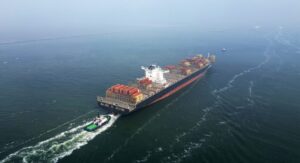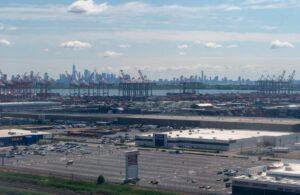A lot of attention has been paid to the carriers and the container vessels which they operate during 2020 considering the issues that the COVID-19 pandemic has caused.
Firstly, blank sailings were used by carriers in response to address huge volume drops across major container trades globally since the outbreak of COVID-19.
The shipping lines have indeed seen their profits increase throughout 2020 despite ongoing challenges, in contrast with many ports and terminal operators which have seen declines.
A mixture of increased freight rates, lower bunker fuel prices, operations savings from blank sailings and reduced charter rates could all be attributed to the profitability that has been felt.
Click here for a deep dive into the success of shipping lines.
Mega-Ships
Mega-ships continued to take to the oceans in 2020 with CMA CGM launching the CMA CGM Jacques Saade and HMM unveiling the final addition to its mega-ship fleet in September 2020, the 24,000 TEU HMM St Petersburg.
Any speculation that there may be a withdrawal of investment into has surely been quashed and the links of OOCL confirmed that it had no plans to scale back its own mega-ship fleet.
In a statement accompanying its first half 2020 results, the carrier said it will continue to play “a leading role in the digitalisation” of the industry, and that its optimism was evident in its order of 23,000 TEU vessels in March 2020.
Even Hapag-Lloyd, which did postpone its mega ship orders, does not seem to suggest that it will not revert back to investing in larger vessels as the carrier said it will reassess plans after the crisis is over.
A commitment it has stuck to as even though the crisis has not yet ended the company announced on 23 December it has ordered six ultra-large container vessels of over 23,500 TEU from Korean shipyard Daewoo Shipbuilding & Marine Engineering.
PTI and other contributors wrote extensively about mega-ships, their viability, whether they will grow in the future and how they are impacting ports in the Beyond the Mega-Ship Revolution edition of the Journal.
Incidents and accidents
Unfortunately, the year did not pass without incidents involving container vessels with the most recent, and possible largest in history, happening in November with the ONE Apus losing up to 1,900 containers while on route to the west coast of the US.
In September a 23,000 TEU vessel took down a crane at the Port of Valencia after becoming entangled in a cable as in manoeuvred into the port.
Meanwhile, in Spring 2020 questions were raised around mega-ships as footages emerged of the Milano Bridge, an ultra-large container vessel (ULCV), knocking over three ship-to-shore (STS) cranes at the Port of Busan, South Korea.
There were also a number of recommendations put into place by the Dutch Safety Board after it suggested revealed that the shipping routes above the Wadden Islands during the northwestern storms form a risk for large, wide container ships.
This follows an investigation into the lessons learned from the loss of containers from the MSC Zoe in 2019.
The ship lost 342 containers and three million kilograms of cargo fell into the sea as a result of meeting severe weather on its journey through the Dutch Wadden Islands.








